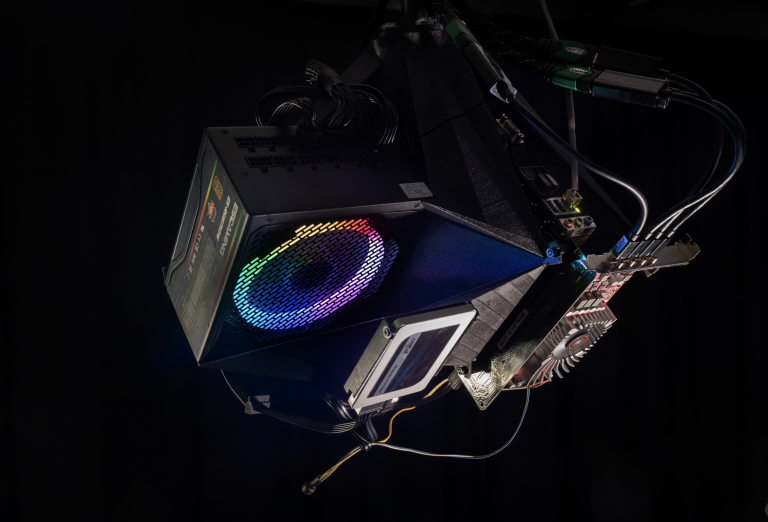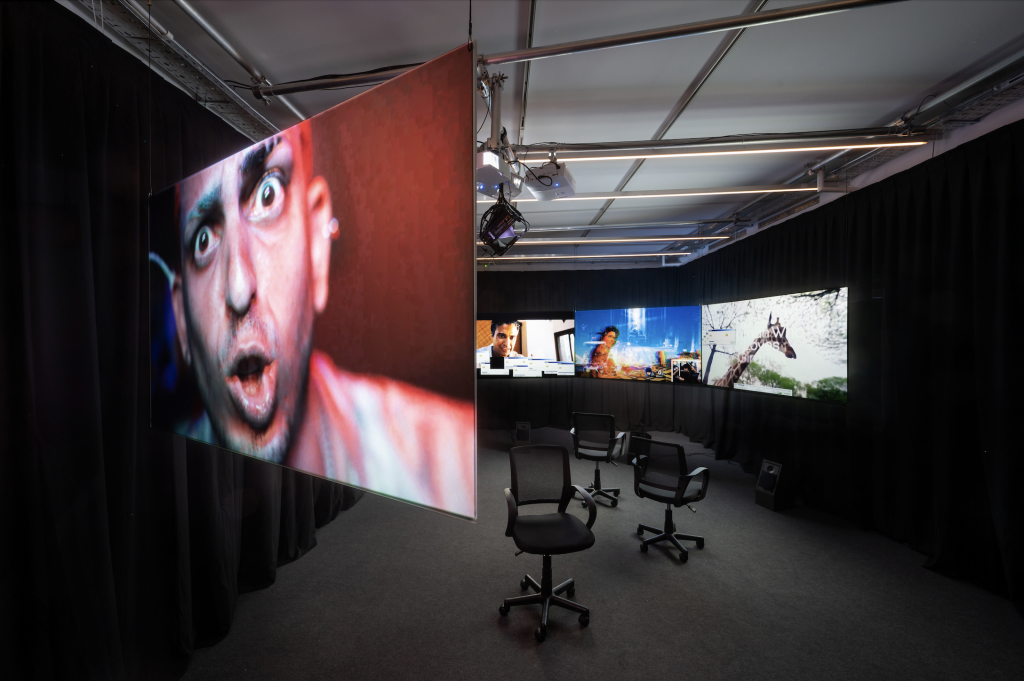2023 | Expanded Cinema Installation | Loop
in collaboration with Nestor Siré and Erick Mota
MEMORIA is an immersive four-channel expanded cinema installation with custom software and hardware elements. It combines ethnographic research, science fiction, and recombinatory forms of cinema that appropriate found or pirated footage.
The work superimposes two narrative layers: the dystopian vision of William Gibson’s Johnny Mnemonic (1981), one of the earliest cyberpunk short stories, and the ethnographic reality of Cuba’s “offline internet”, the physical data distribution network El Paquete Semanal. MEMORIA appropriates Gibson’s fictional story of a data courier who has crucial information locked in his head and projects it onto the Cuban media reality with its informal networks and human infrastructures of data exchange and distribution.
Gibson’s Johnny Mnemonic is a data trafficker who has undergone cybernetic surgery to have a data storage system implanted in his brain. The system allows him to serve as secure storage for digital data too sensitive to transfer across the net and he makes a modest living by physically transporting delicate information for corporations, underworld crime rings or wealthy individuals. As the story opens, Johnny learns that the latest data package that was uploaded to his brain was stolen from the Yakuza who now is after him. With the help of Jones, a heroin-addicted, cybernetically enhanced dolphin who retired from Navy service he tries to get the data out of his head.
Shot in the year in which the plot of Johnny Mnemonic takes place and during a pandemic as described by Gibson in his screenplay for the Hollywood version of his story, MEMORIA explores how Cyberpunk’s s predictions shape our contemporary reality. The work contrasts the imaginary of the Internet in 1980s Cyberpunk literature with the contemporary Cuban experience of the Internet as a particular conglomerate of differing horizons of technical and social possibility. Hence, it examines both sci-fi, as well as real-world alternatives to the mainstream capitalist consumerist version of the net that we are left with today, envisioning more decentralized, (net-)neutral, non-commercial iterations of the web.
MEMORIA is based on long-term ethnographic fieldwork on Cuban alternative data distribution networks. With online access heavily restricted by the government, but also the US trade embargo, Cuba still has one of the lowest internet penetration rates in the world. Yet its citizens have found a way to distribute all kinds of web content in the form of the Paquete Semanal (The Weekly Package), a one-terabyte collection of digital material compiled by a network of people with various forms of privileged internet access. It is circulated nationwide on USB sticks and external hard drives via an elaborate human infrastructure of deliverymen, so-called Paqueteros, who, like Johnny Mnemonic, the main character in Gibson’s story, physically bring the content to the remotest corners of the island and deliver right to their client’s homes. It forms a sort of offline version of the internet and contains data such as the latest episodes of popular Netflix series, funny YouTube videos, pop music albums, downloaded websites, celebrity social media content, anti-virus, and software. Gibson’s work arrived 20 years late on the island via informal media distribution networks through which foreign entertainment materials like novels that were left behind by Western travelers or sent into the country by relatives from abroad were circulated. These networks were the precursors of what later would become the Paquete Semanal.

To represent the memory loss of its protagonist, the work will slowly “die” over the course of the exhibition. For this, we have developed a batch script that runs several programs that continuously manipulate the video. Over time the video devours itself through the constant process of faulty replication, like cancer that makes the cells inside the host grow in a random and uncontrolled way. The speed at which the material deteriorates is adjusted to the duration of the work’s exhibition.
All hardware is housed in a custom case, a sculptural object in itself that was molded and 3D printed from recycled plastic filaments in collaboration with COPINCHA, a hackerspace in Havana that works with local materials and technologies.
CAST
Dayron Villalon
Chris Gómez Gónzalez
CREW
Director of Photography | Nicole Medvecka
Costumes | Raki Fernandez
CGI & VFX | Alexander Bley
Editor | Ginés Olivares, Miguel Coyula
Sound design | Lorenz Fischer & Malte Audick
Music | Johannes Klingebiel

